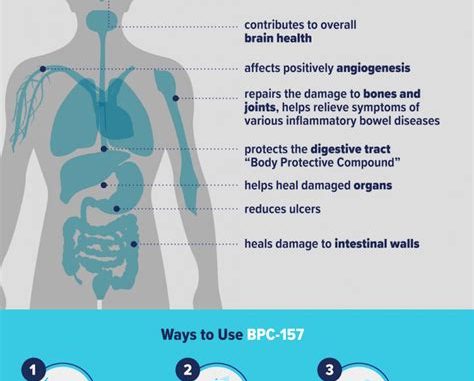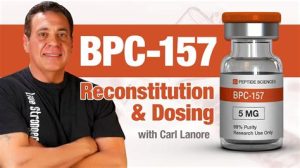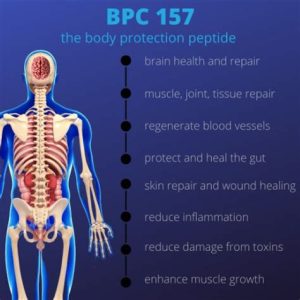
Discover the top 10 benefits of BPC 157, including its impact on muscle recovery, digestive health, and joint improvement. Learn how BPC 157 works. Welcome to the world of miraculous peptides, where healing and recovery are at your fingertips! If you’ve been yearning for a panacea for various physical woes, then BPC 157 may just be your Holy Grail. BPC 157, a peptide expertly crafted by your very own body, has been garnering attention for its remarkable potential in healing and rejuvenation.
As we dive into the top 10 benefits of BPC 157 that you should absolutely be aware of, prepare to be enlightened on how this potent sequence of amino acids is changing the game in both muscle restoration and holistic health. From mending muscles to soothing the stomach, and fortifying joints, BPC 157 could very well be the secret ally your body has been dreaming of. So, buckle up: we’re about to embark on a journey through your body’s natural wonders and discover how BPC 157 can seamlessly integrate into your wellness routine.
What is BPC 157?
BPC 157, a peptide consisting of a sequence of amino acids, has emerged as a prominent subject in the field of medical research due to its potential therapeutic effects. Originally isolated from human gastric juice, its name stands for Body Protection Compound, reflecting its capability to convey various protective and regenerative benefits to the human body. As scientists delve deeper into its properties, BPC 157 is becoming a beacon of hope for those seeking accelerated healing and restorative treatments.
The intrigue surrounding BPC 157 is not unfounded; it’s credited with an impressive range of biological activities, encompassing the modulation of growth factors typically involved in tissue repair and wound healing. While primarily investigated in animal models, the applicability of these findings to human health continues to be a significant point of interest, positioning BPC 157 as a potential game-changer in the realm of regenerative medicine and beyond. Its ability to positively influence cell survival and migration underscores the vital role it could play in recovery processes and therapeutic strategies.
At the heart of the discussions about What is BPC 157, lies the understanding that this compound might represent a new frontier in personalized medicine, especially for conditions that have long eluded conventional treatment options. The properties of BPC 157 suggest it might one day be the cornerstone of protocols designed for the healing of soft tissues, the improvement of gastrointestinal health, and the strengthening of the musculoskeletal system, although robust clinical research is still required to fully substantiate these promising indications.
How Does BPC 157 Work?
The inner workings of BPC 157, a sequence of amino acids with powerful healing properties, have intrigued the scientific community, leading to extensive research on its mechanisms of action. Upon administration, whether by injection or orally, BPC 157 operates by modulating the body’s natural regenerative processes, signaling the repair and growth of tissues at a cellular level. Its ability to improve angiogenesis, the formation of new blood vessels, is particularly critical, as this underpins its remarkable efficacy in accelerating wound healing and tissue regeneration.
Further delving into the biological interactions, it is revealed that BPC 157 influences the expression of genes associated with cytokines, growth factors, and hormones involved in tissue repair. This activity not only hastens recovery timelines but also effectively mitigates inflammation, a common impediment to healing. Moreover, the peptide’s upregulatory effect on the nitric oxide pathway enhances its authenticity as a protector against injury and stress to various organ systems.
Through its synergetic actions with multiple bodily systems, BPC 157 ensures the maintenance of homeostasis and promotes improved outcomes in physical repair scenarios. One example is its notable impact on tendon-to-bone healing, indicating that its efficacy is not limited to soft tissue repair but extends to reinforcing the musculoskeletal connections essential for routine movement and stability.
Overall, the multi-faceted approach that BPC 157 employs to mend and strengthen the body is a testimony to its potential as a therapeutic agent. Its ability to interface with the body’s complex biochemistry while fostering recovery processes denotes a progressive leap forward in the realm of regenerative medicine.
Benefits for Muscle Healing
The complex orchestration of tissue repair involved in muscle healing can be significantly influenced by the peptide known as BPC 157, which stands for Body Protection Compound 157. This remarkable peptide, originally derived from a protein found in the stomach, has gained substantial attention for its profound healing properties that are particularly beneficial for athletes and those engaged in strenuous physical activities. Its regenerative capabilities are not only limited to the realms of muscular development but also extend to the intricate musculoskeletal details that encompass the overall challenges of recovery from muscular injuries.
When addressing the benefits of BPC 157 for muscle healing, one cannot help but highlight its potential to accelerate the reparative processes post-injury, thereby reducing the time frame required for muscles to recuperate. Indeed, the robust influence of this peptide on the modulation of angiogenesis—the formation of new blood vessels—is notably instrumental in the delivery of nutrients and the clearance of waste products at the affected site, thereby enhancing the conditions necessary for optimal repair and regeneration of muscle fibers. Moreover, the use of BPC 157 in various studies has exhibited a marked reduction in inflammatory markers, signifying a more restrained inflammatory response, which is quintessential in avoiding excessive scar tissue formation and ensuring the proper alignment of regenerating muscular tissues.

Furthermore, elucidating the interplay between BPC 157 and the body’s natural growth factors reveals the peptide’s proclivity to foster an environment conducive to healing. The upregulation of growth hormone receptors implicated in muscle repair, as seen with BPC 157 administration, suggests a synergistic interaction that promotes cellular growth, differentiation, and proliferation essential for repairing muscular damage. This scientific evidence thus positions BPC 157 as a seminal agent in the advancement of muscle healing, constituting a pivotal breakthrough in recovery protocols and potentially reshaping the modalities employed in recuperative medicine.
The implications of BPC 157 as a therapeutic adjunct in the realm of muscle healing do not just encompass the biochemical phenomena that transpire on a microscopic level but also translate into more tangible outcomes such as enhanced performance, decreased likelihood of reinjury, and an overall improved quality of life for individuals who incorporate this powerful peptide into their health regimen. As research continues to delve into the myriad of benefits conferred by BPC 157, it is becoming increasingly clear that its role in musculoskeletal health could herald a new era in the optimization of natural healing processes.
Effects on Digestive Health
The intricate workings of the digestive system are crucial to our overall health, and BPC 157, a powerful pentadecapeptide, has shown promising results in promoting digestive health. Known for its incredible healing properties, BPC 157 influences the gastrointestinal tract, offering support and healing to damaged tissues. Engaging in the meticulous repair of the lining, this peptide plays a pivotal role in fending off ulcerations and treating gastrointestinal disturbances.
Another area where BPC 157 has made its mark is in its ability to regulate and enhance the blood flow to the digestive organs. This is of paramount importance because a well-oxygenated gastrointestinal system is better equipped to repair itself and maintain optimal function. Moreover, by elevating the angiogenic repair processes—the formation of new blood vessels—the body is empowered to create a robust network that supports tissue regeneration and healing, particularly in the intestinal areas that have suffered damage.
Individuals suffering from inflammatory bowel disease (IBD) or irritable bowel syndrome (IBS) may find a respite in the effects of BPC 157. Through its significantly potent anti-inflammatory properties, this peptide has been observed to reduce inflammation in the gut, offer relief from discomfort, and aid in managing the symptoms associated with these chronic conditions. Therefore, BPC 157 is not only seen as a facilitator in the healing of physical damage but also as a potential therapeutic agent that brings control and ease to the tumultuous symptoms of gut-related diseases.
Not to be overlooked is BPC 157’s potential in the fight against leaky gut syndrome, a condition that is becoming increasingly recognized in the medical community. By strengthening the gut lining and improving its integrity, BPC 157 helps prevent the passage of harmful substances into the bloodstream, and thereby, maintains a defensive barrier critical to one’s well-being. This aspect of the peptide’s function is particularly intriguing, as it aligns with the proactive attitude towards preserving digestive health and preventing the multitude of complications that can arise from a compromised gastrointestinal system.
Improvement in Joint Health
As we delve deeper into the multifaceted benefits of BPC 157, a peptide that has captured the attention of the health and wellness community, the improvements in joint health stand out as a point of particular interest, particularly for individuals experiencing joint pain and stiffness. The regenerative capabilities of BPC 157, when it comes to repairing and maintaining joint tissues, speak volumes about its potential as a therapeutic agent. Research has illuminated the pathway through which BPC 157 stimulates the healing of tendons and ligaments, suggesting a ripple effect that may extend to improved general joint function.
For those wrestling with chronic conditions such as osteoarthritis or rheumatoid arthritis, the potential impact of BPC 157 on joint health could mean a significant shift in the management of their symptoms and potentially in their quality of life. Studies have shown that consistent administration of this peptide can facilitate the recovery of joint mobility, decrease inflammation markers, and encourage the regeneration of joint tissues, hence embellishing the body’s natural ability to heal and fortify itself against the onslaught of degenerative joint diseases.
Furthermore, athletes and physically active individuals who regularly put their joints under high stress might find the administration of BPC 157 to be a boon in maintaining joint health and resilience, mitigating the wear and tear that comes with repetitive motion and intensive activity. By bolstering the healing process after injury and reducing the risk of future joint issues, BPC 157 emerges as a beacon of hope for those looking to maintain an active lifestyle well into their later years, and for whom joint health is paramount. It operates not just on the cellular level but also manifests in the noticeable enhancement of joint comfort and function – a testament to its systemic therapeutic applications.

Thus, while the scope of BPC 157’s benefits continues to grow as more research is undertaken, the promise it offers in the realm of joint health improvement remains one of its most compelling uses. This peptide’s therapeutic effects have been documented in various studies, and although more rigorous clinical trials are needed, the anecdotal and preliminary evidence positions BPC 157 as a significant player in the push toward regenerative medicine and the holistic management of joint health.
Frequently Asked Questions
What is BPC 157 and where does it come from?
BPC 157 is a peptide chain consisting of 15 amino acids. It is a partial sequence of body protection compound (BPC) that can be found in human gastric juice. It is known for its regenerative and healing properties.
How does BPC 157 promote muscle and tendon healing?
BPC 157 works by promoting the formation of new blood vessels, a process known as angiogenesis. This enhances the blood flow to damaged tissues and facilitates the repair and regrowth of muscles and tendons.
Can BPC 157 help with joint health?
Yes, BPC 157 may improve joint health by reducing inflammation, promoting tissue healing, and potentially regenerating ligaments and tendons, which can help maintain joint flexibility and alleviate pain from conditions like arthritis.
Is BPC 157 effective for gastrointestinal issues?
BPC 157 originated from a protective protein found in the stomach and has been found to be very effective in treating various gastrointestinal disorders, including ulcers, inflammatory bowel disease, and Crohn’s disease due to its regenerative properties.
Are there any benefits of BPC 157 for the skin?
BPC 157 can benefit the skin by accelerating wound healing, reducing the appearance of scars, and promoting the production of collagen, which improves skin elasticity and strength.
Does BPC 157 have any nootropic effects on brain health?
Research suggests that BPC 157 may have neuroprotective properties, potentially aiding in the recovery from traumatic brain injury and reducing symptoms of depression. It’s believed to assist in nerve regeneration and improve cognitive function.
Is it safe to use BPC 157 and are there any known side effects?
While research on BPC 157 suggests it has a high level of safety and is well-tolerated in animal studies, long-term human studies are limited. As with any supplement, there may be potential side effects, so it’s recommended to consult with a healthcare professional before usage.

Leave a Reply